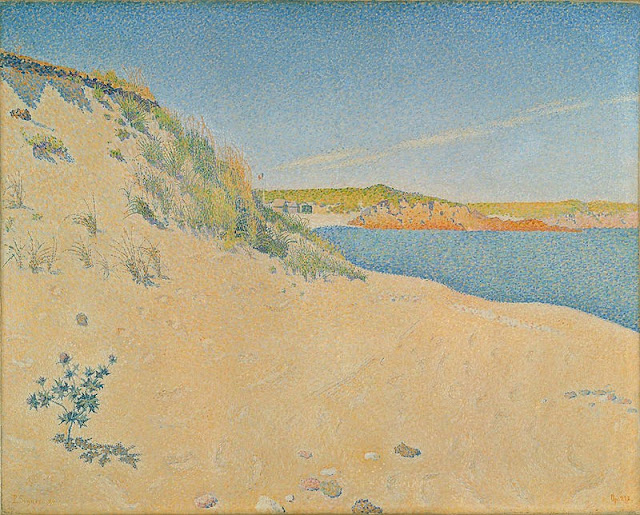Art Insights - Beach At Saint-Briac by Paul Signac
The French-born painter Paul Signac was known for his artworks in various styles — from Impressionism to Divisionism. Yet, it was the Pointillism — a technique of painting that resembled its name and was developed in 1884 by Signac and his fellow artist Georges Seurat. Pointillism’s artworks consisted of thousands of small colored dots, and these paintings were easy to recognize.
Beach At Saint-Briac was created in 1890, and soon it marked a sad moment in Signac’s life. Georges Seurat died in 1891, and Signac was deeply saddened by the passing away of his friend. Pointillism no longer remained a passion for its creator. “I more and more despise this dry little dot,” he wrote about his mood those days.
 |
| Beach At Saint-Briac. Oil on canvas, 1890. |
Signac was stepping away from the movement he created, but it still had a place in his works. He adjusted his technique, and instead of dots, the painter added more of a contrast to the brushwork. Signac started to use more acidic colors in his works, but Beach At Saint-Briac remained one that represented the roots of his artistic journey. The colors he used were realistic. The sand is yellow, the sea and sky are blue, same with all the plants. Everything has the right tones, and the overall scene looks less monumental and static than the other examples of Pointillism.
Signac had a great passion for sea travel. He switched yachts often (32 times during his lifetime). His first boat was purchased in 1883, and the painter named it Monet — Sol — Wagner. Besides painting, Signac was a great enthusiast of music and literature. He often named his paintings, using various musical motifs, such as Adaggio, Allegretto, Stretto, and others. Beach At Saint-Briac also has a musical subtitle — Opus 212. It was presented at the Paris Salon in 1891.
The French writer Paul Vaillant-Couturier once said: “Signac loved art, humanity, and sea”. It was true. Signac had a very emotional character. He was open-minded, and his brushwork often was very spontaneous. It was all about representing his inner emotions in the purest way possible, not about the academic theory of applying the colors.
Of course, he was not the most emotional artist out there. Signac had a temper, but his works were still perceived as too formal. “I choose colors not by the academic standards, but based on my feelings, observations, and experience. Artists, like Signac, are basing their works on some ideas of Delacroix. Takes care of the additional colors, adding one tone here, another one there. All based on the theory. I try to add the colors on a canvas that represent my feelings,” wrote Henri Matisse.
 |
| Cassis, Cap Lombard, Opus 196 by Paul Signac. Oil on canvas, 998 cm × 835 cm. |
There is some truth in such a statement. However, Beach At Saint-Briac carries an atmosphere and mood that cannot be viewed as an academic one. It presents a very poetic mood and scenery. Very light and playful, but also calming. Signac created a similar work year earlier, depicting the village of Cassis — Cassis, Cap Lombard, Opus 196. This painting embodied the same sentiments as the Beach At Saint-Briac. Signac’s love towards the sea and everything related to it.
As you might suggest, Signac’s Pointillism movement inspired some of his contemporaries. The most famous of them was Vincent van Gogh, who did his self-portrait in 1887 in this manner. He met Signac a year earlier in Paris, and they worked together on the landscape paintings. Signac’s style was indeed simple but remarkable and van Gogh held it in high regard.
Comments
Post a Comment